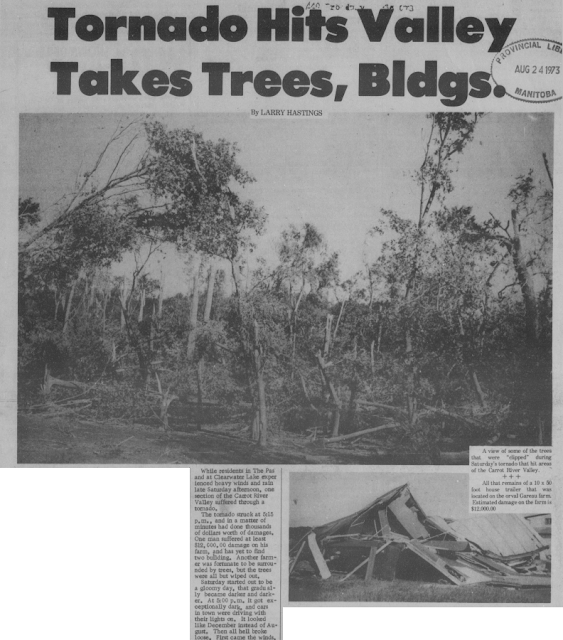August 29, 1910 Thunderstorms Cause Mostly Lightning Damage
Widespread thunderstorms affected southern Manitoba on August 29, 1910. In Winnipeg, two waves of thunderstorms hit. The first storm hit at about noon and brought heavy rain. The sky was apparently so dark that it was necessary to turn on the lights indoors. About 18 mm fell with this storm. The second storm struck about 8 pm and lasted about two hours. It brought strong winds, heavy thunder and vivid lightning. Not much damage was reported however. The bulk of the damage caused by the storms was by lightning. A hay stack north of the city in Rosser took fire by a lightning strike, and was plainly visible from the city. 36.1 mm of rain fell from the two storms at St John's College according to the Tribune.
 |
| Winnipeg Tribune Aug 29, 1910, page 9 |
Other parts of southern Manitoba weren't so lucky as Winnipeg. The Winnipeg Beach area was hard hit. Hundreds of trees were knocked down and a ''good-sized'' boat was lifted into the air by the wind. The wind was apparently even enough to push water away from the shore, exposing more beach than usual. The storm scared away many campers the following two days. Businesses were not too pleased with their departure.
Other storm reports:
Birtle - The heaviest rain of the season. The storm tore off the metal roof of a terrace. North and west of town, grain fields were flattened. To the east, it was just a shower.
Russell - A severe storm of wind, rain and hail in some localities in this district. Some damage to uncut grain. Telephone lines were damaged as well.
Souris - Worst storm of the season in the morning, with heavy rain. A residence was damaged considerably by lightning. The rain was very heavy in town and north, but lighter in the south.
Elgin (south of Souris) - Severe electrical storm south of town about 8:30 am. A new barn was struck by lightning and burned to the ground. A man received a severe shock from the lightning strike.
Macgregor - A barn was struck by lightning and damaged considerably. Two horses were killed. Telegraph wires were damaged by the storm.
Baldur - A horse was killed by lightning.
Portage la Prairie - Three barns at Island Park were struck by lightning about 1 pm and burned to the ground. Heavy rain accompanied by the storm has delayed harvesting for the time being.
Kenora - Much needed rain throughout this entire district at night with intervals of lightning.
 |
| Winnipeg Tribune Aug 30, 1910, page 1 |
This post contains information from the Winnipeg Tribune, Winnipeg Free Press, Baldur Gazette, Birtle Eye Witness, Russell Banner and ECCC.
































